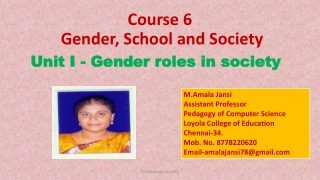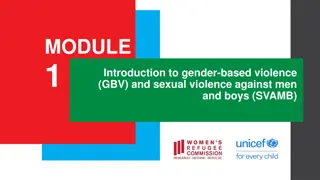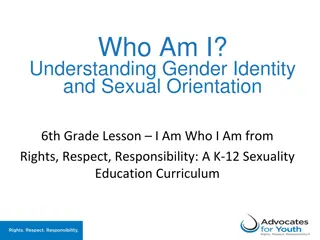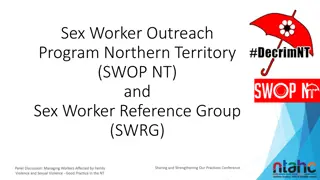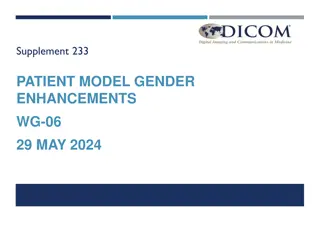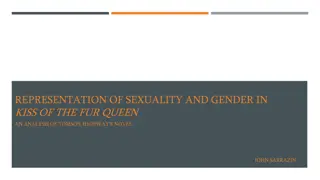Understanding Gender, Sex, and Sexuality in Psychology
Exploring the concepts of gender, sex, and sexuality in psychology, this educational material covers topics such as defining sex and gender, theories of gender development, sexual orientation, sexual behaviors, variations, and disorders, as well as the impact of sexuality on health and wellness. It delves into properties determining male or female, defining external genitalia, gender identity, sexual development, and disorders in sexual development.
Download Presentation

Please find below an Image/Link to download the presentation.
The content on the website is provided AS IS for your information and personal use only. It may not be sold, licensed, or shared on other websites without obtaining consent from the author. Download presentation by click this link. If you encounter any issues during the download, it is possible that the publisher has removed the file from their server.
E N D
Presentation Transcript
Gender, Sex and Sexuality AP Psychology Alice F. Short Hilliard Davidson High School
Chapter Preview Defining Sex and Gender Theories of Gender Development Gender Differences Sexual Orientation Sexual Behaviors and Practices Sexual Variations and Disorders Sexuality and Health and Wellness
Properties that determine male or female 23rd pair of chromosomes: XY or XX pair of genes gonads = glands (part of endocrine system) ovaries (either side of abdomen) testes (in scrotum, the pouch of skin below the penis) gonadal hormones: estrogens or androgens gametes the ova and sperm will be used in reproduction internal reproductive structures DOCUMENTARY: It s a Girl Defining Sex
Defining Sex external genitalia female: vulva mons pubis a fleshy area just above the vagina labia lips surrounding the vaginal opening clitoris a small sensory organ at the top where the labia meet male penis scrotum secondary sex characteristics (at puberty) traits that differ between the two sexes but are not part of the reproductive system breasts facial hair sex may not equal psychological experience (gender)
Defining Gender gender - social and psychological aspects of being female or male goes beyond biological sex includes a person s understanding of the meaning to his or her own life of being male or female Gender Identity masculinity (instrumentality) femininity (expressiveness) androgyny (both) undifferentiated (neither)
Sexual Development embryonic development of gonads and genitalia SRY gene testes androgens male physiology female is default condition gender differences in regards to the brain size of brain parts function of brain parts corresponding cognitive function which part of brain involved in particular behaviors
Sexual Development Disorders of Sexual Development formerly called intersex conditions / hermaphroditism congenitally atypical chromosomal, gonadal, or anatomical development questions of relation of DSD to gender development Transgender Experience Gender Identity Disorder not considered a disorder in France or Great Britain gender dysphoria distress over one s born sex sex reassignment surgery
Gender Development Biological Accounts behavioral difference in newborns and infants Evolutionary Accounts selection pressures for gendered behaviors competition for mate (usually by male) preferences/choice for quality mate (usually by female) reproductive challenges: quality v. quantity human infants = helpless adaptive for men to invest in their offspring is it mine? (younger ladies)
Gender Development Social Cognitive Accounts experience influences sense of gender socialization (rewards, punishments, modeling) Albert Bandura modeling is an especially potent mechanism for transmitting values gender schema (mental framework) gender-nonconforming behavior peers = harsher than family after age 6 DOCUMENTARY: Miss Representation (You can t be who you can t see.)
Gender Development Social Role Theory division of labor natural differences become expected/valued differences gender roles expectations for how females and males should think, act and feel gender stereotypes overly general beliefs and expectations about what women and men are like institutional structures patterns of opportunity that perpetuate gender differences women have resources less likely to prefer men with resources TED Talks: Sheryl Sandberg Summary of Gender and Gender Development Theories on p. 357
Gender Differences Who are more ___________? For each adjective on the next slide, answer as quickly as you can with either men or women .
Gender Differences Who are more . . . assertive rational emotional aggressive strong sexually adventurous creative reserved verbal active
Gender Differences Cognitive Differences math and science? verbal performance (female advantage) visuospatial ability (male advantage) general intelligence (no advantage) Differences due to: social expectations and support v. evolved roles gender similarities hypothesis Janet Shibley Hyde s proposition that men and women (and boys and girls) are much more similar than they are different
Gender Differences Differences in Aggression overt aggression (physical/verbal harm) males more than females relational aggression (harm social standing) females more than males severely damaging psychologically why the difference? testosterone? evolutionary pressures? socialization? conduct disorder a pattern of offensive behavior that violates the basic rights of others (3x more like in boys)
Gender Differences Differences in Sexuality (p. 360-361- Inquiry) females more selective in regards to casual sex bed = none, apartment = very few, going out = 50% males more often aroused, stronger sex drive, less fidelity bed = 75%, apartment = 70%, going out = 50% women more likely to engage in bisexuality or be aroused by bisexual stimuli; show changes in their sexual patterns/desires Explanations: biological - genetic/hormonal differences evolutionary - sexual selection social cognitive - learned behavior social role - culturally constructed
Sexual Orientation sexual orientation - direction of erotic interests - refers to more than just sexual behavior Orientations: (operational definition matters) heterosexual (90% of population) homosexual (1500 animal species) bisexual
Sexual Orientation Orientation is not influenced by being reared by a gay parent parenting style childhood sexual experimentation
Origins of Sexual Orientation Thinking critically about sexual orientation: probably not a single cause within-group variation research challenges such as recruitment meaning of cross-sex similarities consideration of more than just homosexuality
Sexual Orientation Orientation is influenced by genetics corpus callosum thickness and hemispheric symmetry prenatal hormones 2D:4D ratio women have the same length men / butch lesbian women have a ring finger longer than their pointer (male prenatal androgens) cognitive factors social factors (gender non-conforming behavior)
Gay and Lesbian Functioning similarities to heterosexual population attitudes, psychological adjustment difference from heterosexual population hobbies, activities, occupations coping with prejudice and discrimination 1984: 24% knew someone gay; 2006: 70% knew someone gay Generation Next (1981-1988): 58% homosexuality should be accepted, just under thought same-sex marriage should be legal coming out
Gay and Lesbian Functioning Relationships report greater satisfaction than heterosexuals kids reduce happiness / relationship satisfaction more likely to end relationships than heterosexuals legal tie of marriage associated with relationship stability Families less likely to have children children of gay couples have not shown differences from other children
Sexual Behavior What constitutes sexual behavior? infidelity or loss of virginity activities involved in reproduction arousal and sexual response unusually intimate and personal activity as defined by the participants What do you think constitutes sexual behaviors? Does that definition change when you think about cheating?
Kinseys (1948) research 12% men, 7% women = bixsexual are most people promiscuous or faithful? 50% men = unfaithful later research: 85% women, 75% men = faithful does marriage decrease sexual activity? what percentage of the population are virgins? aged 15-44: men 10%, women 8% aged 25-44: 3% how often do we have sex (on average)? who masturbates the most? men (per month): vaginal intercourse: 5 times masturbation: 4.5 times oral sex: 2 times Women (per month) vaginal intercourse: 5 times masturbation: fewer than 2 times oral sex: 2 times Sexual Behavior
Sexual Response Pattern Human Sexual Response Pattern (William Masters and Virginia Johnson) 1. excitement begins the process of erotic responsiveness several minutes to several hours engorgement of blood vessels, increased blood flow to genital areas, partial penile erection 2. plateau continuation and heightening increased breathing, pulse rate, blood pressure penile erection / vaginal lubrication complete 3. orgasm 3-15 seconds explosive charge of neuromuscular tension release of neurotransmitter oxytocin 4. resolution/male refractory period blood vessels return to normal state Helen Singer Kaplan: initials stage of desire should be added some patients lacked sexual desire
Sexual Cognition Cognitive factors in sexual behavior self-monitoring and self-regulation fantasy and imagery sexual scripts
Influences on Sexuality Influence of Culture Inis Beag Mangaia Sex Education abstinence-only v. comprehensive
Sexual Variations and Disorders fetishes paraphilias pedophilia disorders of sexual desire/response female dysfunction in arousal erectile dysfunction, premature ejaculation
Sexuality and Health and Wellness Sexually Transmitted Infections bacterial: gonorrhea, syphilis viruses: genital herpes, HIV Safe Sex abstinence 100% effective risk reduction with condom use Psychological Well-Being sexual activity is predictor of satisfaction in relationships
Chapter Summary Define the terms sex and gender . Explain the biological, evolutionary, social- cognitive, and social role accounts of gender development. Summarize the well-documented gender differences. Describe the similarities and differences among gays, lesbians, and heterosexuals. Discuss sexual variations and disorders. Explain how sexuality affects health and wellness.
Chapter Summary Defining Sex and Gender Theories of Gender Development biological evolutionary social-cognitive social roles Gender Differences
Chapter Summary Sexual Orientation influences on sexual orientation gay and lesbian functioning and relationships Sexual Behavior sexual activity human sexual response pattern Sexual Disorders Sexuality and Health and Wellness sexually transmitted infections



